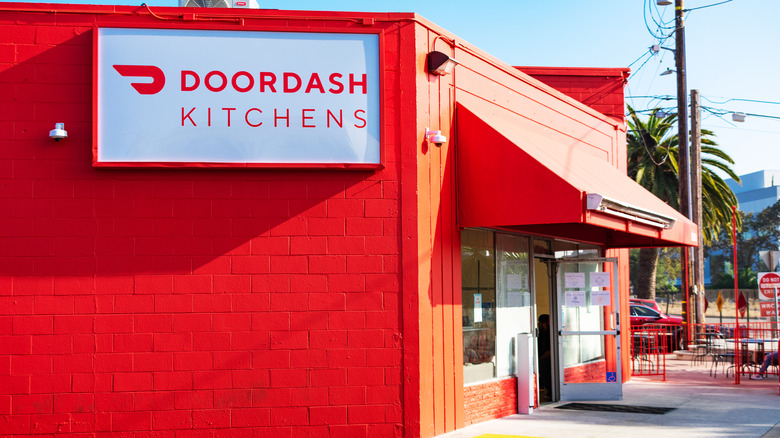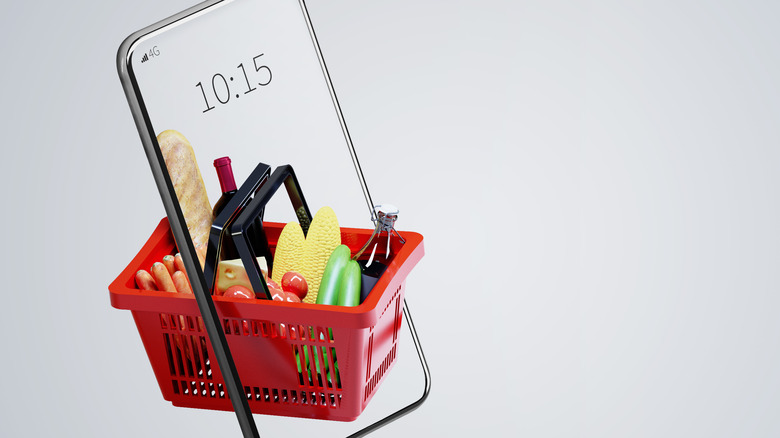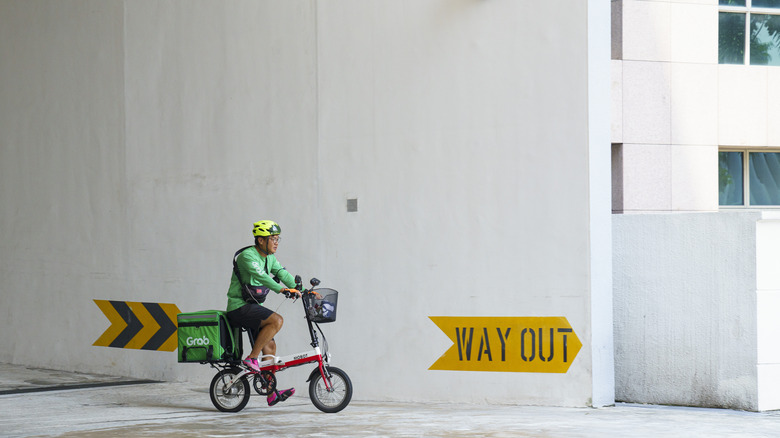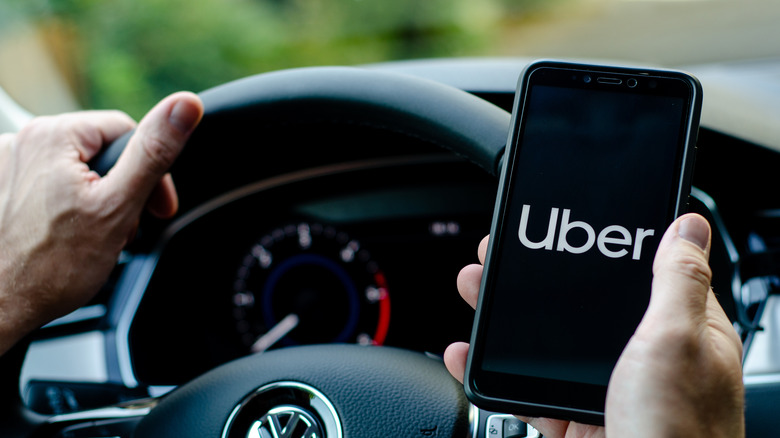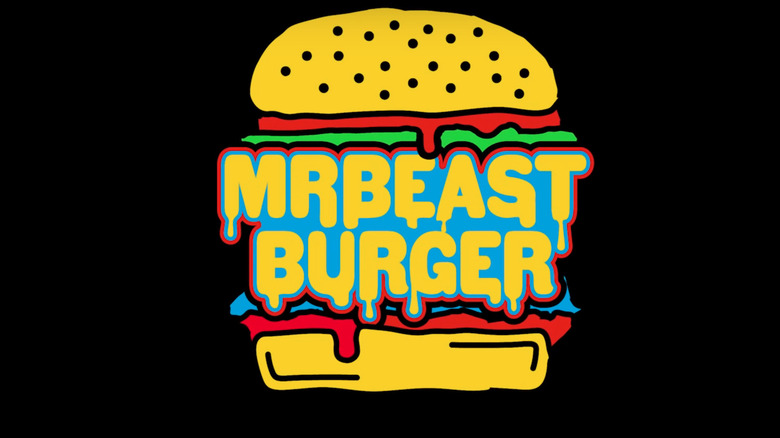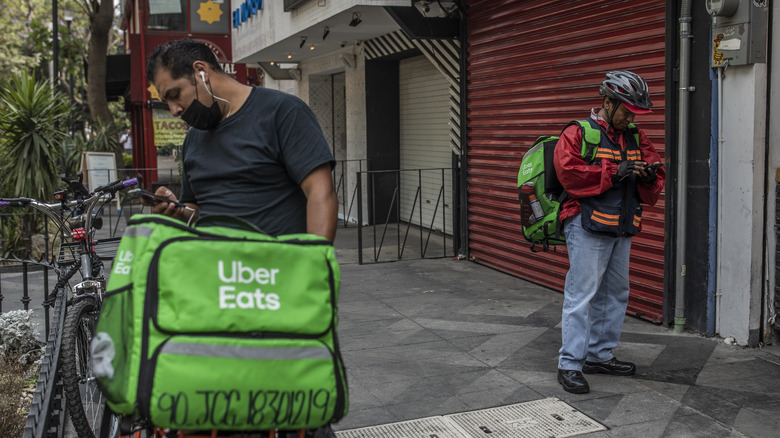Is There Really A Difference Between A Ghost Kitchen And A Virtual Restaurant?
The coronavirus pandemic has birthed, well, a plague of terms concerning delivery-only enterprises. As the widespread nature of delivery-only restaurants has only occurred recently, the industry is still struggling to figure out how each enterprise should label itself. However, most of these ventures fall under the category of ghost kitchen or virtual restaurant.
James O'Reilly, CEO of the casual dining chain Smokey Bones, explained to On-Trend Concepts that the difference between a ghost kitchen and a virtual restaurant is that a ghost kitchen exists as an "off premise" kitchen while virtual restaurants are a digital only brand. Virtual brands can hire regular kitchens or ghost kitchens to prepare their meals. Ghost kitchens can work with both virtual brands and, as Bon Appetit reported in April, established brands like Wendy's as they want to ensure customers ordering delivery receive their food more quickly. Neither have a dining room, making both delivery-only enterprises.
All the bonuses of delivery without the restaurant costs
The reasons one might want to open a ghost kitchen all come down to cost cutting. POS system Toast's blog On The Line expresses this point in three distinct ways. Namely, sharing a kitchen space allows you to split the costs with other chefs. You save money by not having to pay for a front-of-house area that during the pandemic is a major drain on restaurant resources. You can redeploy labor across different projects within the same ghost kitchen.
A similar theme can be applied to virtual restaurants. For example, when Tender Shack, a virtual restaurant brand owned by the same company that controls Outback Steakhouse, decided to expand their operations nationwide, their CEO expressed the logic to Nation's Restaurant News as follows: "Pursuing the virtual brand opportunity with a concept like Tender Shack provides incremental sales with attractive margins and requires zero capital investment." In less jargon heavy wording, Tender Shack brings in enough money without Bloomin' Brands having to pay a thing. They manage this by using the kitchens of Carrabba's Italian Grills, which they also own.
So, ghost kitchens allow new businesses or companies looking for delivery outposts to expand without the expense of a permanent location. Virtual restaurants are an idea that can be used in a ghost kitchen, redeployed in one's own kitchens, or, as we shall see, licensed to third parties in a loose franchise relationship.
Digital ideas can still have analog problems
Enticing and innovative as they may seem, virtual restaurants and ghost kitchens present problems for both the producer and the customer.
By removing the front-of-house and all other concrete aspects of running a culinary enterprise, you have essentially jettisoned 30 percent of all possible profits, Dan Fleischmann, vice president of the restaurant-centric venture fund Kitchen Fund, explained to CNBC. There's a reason why restaurants, even those with delivery options, have struggled during the pandemic.
Then, there's the fact that these delivery-only establishments largely rely on third party delivery apps to attract customers. These apps can also charge a 15-30% fee for delivering the food, CNBC notes, because without them the business could not function. So, the business logic of ghost kitchens and virtual restaurants operate under an estimated 45% sales loss for every shift. That is not economically sustainable, even in the precarious restaurant industry.
On the customer's end, the obscured nature of where and by whom your food is prepared adds an unnecessary level of uncertainty. As In the Know reports, the nature of ordering on a delivery app has allowed for many chain restaurants to pass themselves off as local enterprises. For example, In the Know reveals that Pasqually's Pizza & Wings, a restaurant that appears here and there across the country, is actually a ghost kitchen operating out of Chuck E. Cheese's. In other words, you can't always trust what you order.
Ghost kitchens aren't illegal, but should have more oversight
The shadiness of who owns a ghost kitchen, virtual restaurant, whatever, may inspire doubts in some as to the legality of the enterprise. This is especially true with the Chuck E. Cheese's example just mentioned. However, as In the Know notes, there is technically nothing illegal about this. Sure, companies should be transparent, but they don't have to be.
What has made some restaurants more antsy for regulation is how delivery-only restaurants have their own unfair advantages. Nation's Restaurant News wrote in February 2020 about how worried restaurants were that ghost kitchens neither have to have anywhere near the same starting capital as a restaurant nor, more importantly, face the same regulatory scrutiny as a restaurant that operates as a dining establishment.
Here's where the Uber comparison comes in. Uber, a company that both The New York Times and Forbes attest has never made a profit, only succeeded in undermining the regulated taxi industry by claiming that they were a platform to connect drivers to riders. In the restaurant industry's case, delivery apps are the Uber. While many people with aspirations of restaurant ownership flock to ghost kitchens as the most available solution, it feeds a monopolistic marketplace that lacks both regulations and protections for workers and customers. While the restaurant industry has not become as monopoly-driven as Uber yet, it's worth noting that Uber also owns the major delivery app Uber Eats, so we'll see.
MrBeast Burger is a virtual restaurant
The biggest of the actors in this newly ballooning space is MrBeast Burger, helmed by YouTube star MrBeast. When the brand was going through its second wave of expansion, The New York Times dubbed it a "ghost franchise," which is technically a term for a virtual restaurant.
The way MrBeast Burger works is by partnering with "virtual restaurant partners," which are restaurants that happen to make MrBeast Burger. It is this partnership relationship that allowed MrBeast Burger to, as The New York Times described, appear with 300 "locations" overnight. By calling it a "ghost franchise," however, The New York Times strikes at the point more accurately than the marketing nonsense that is "virtual restaurant." As ghost kitchens are spaces that allow various enterprises to produce their delivery meals, ghost franchises allow many regular kitchens nationwide to sell products from the same virtual restaurant brand.
Mashed's coverage of MrBeast Burger notes that Brio Italian Grille, Buca di Beppo and Bravo Italian Mediterranean are all restaurant chains that have partnered with MrBeastBurger. All these chains are also owned by Earl Enterprises. Earl Enterprises is owned by Robert Earl who also owns Virtual Dining Concepts, which includes MrBeast Burger in their portfolio of "virtual restaurants." While there is nothing inherently wrong with this setup, the fact that it all occurs behind closed doors adds to the shadiness, similar to that of Chuck E. Cheese's and Pasqually's Pizza and Wings. Underutilized restaurant kitchens have found innovation and a ghost franchise to haunt their brand.
Virtual and ghost kitchens are a natural trajectory
While this piece started with a bad pun about the coronavirus pandemic, the truth is that ghost kitchens were a growing phenomenon even before everyone had to order delivery.
In January 2020, two months before the United States first locked down, The Motley Fool wrote that ghosts kitchens could become big due to the growing costumer preference for delivery, as seen in the increased use of delivery apps and the growing cost of labor. In a somewhat dystopian if realist explanation, they explain that "restaurants heavily concentrated in expensive labor markets, like California, are particularly vulnerable as the minimum wage continues to creep up. Saving money by cutting staff with a ghost kitchen model may be the answer." As with every other aspect of the economy, the trend is not to invent a system in which workers can have some semblance of a livelihood, but innovate a means to reduce the labor pool and further isolate communities.
Whether ghost kitchens and virtual restaurants will retain their popularity as more and more people feel comfortable with the idea of eating in a restaurant again has yet to be seen. However, with the industry decimated by the effects of the pandemic, this ghostly business model has had plenty of time to develop a strong foothold.
